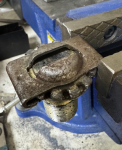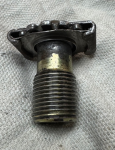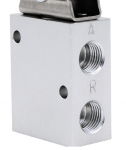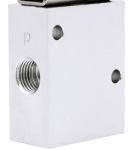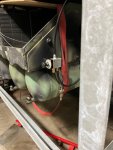There should be 4 airlines On the hydraulic manifold. On the rear side of the wet tank is the air brake protection valve(looks like a pressure regulator), which only lets air out of the wet tank if the wet tank is above ~85PSI. After that there is a large hose up to feed CTIS and the fan/power divider valves under the dash, and a small hose that feeds the cab suspension control valve. The output small line runs to the height control valve.
the other air input to the hydraulic control valve assy comes from a remote control valve either at the service tanks on the A0 or over the rear axle on the A1 trucks. This remote control only allows air to supply the AOP control valve in the hydraulic control assy, if the park brakes are set… the output from that AOP control button feeds the AOP.
I use a valve similar to what you pictured to control my cab suspension. It feeds air from that small line off the wet tank protection valve in one position, and allows air to flow from the suspension back out the vent port to deflate the suspension in the other position…
View attachment 946095



